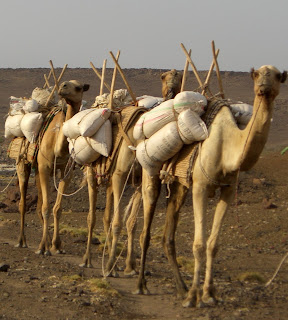
Djibouti, Africa’s smallest country, sits on the junction of three tectonic plates (the African, Arabian and Somalian), two of which are moving apart at an average rate of 2cm a year, creating new land in the rift between them. Apparently this is the only place on Earth where this process is visible, as all other constructive plate margins are under the oceans. It gives rise to hot springs, frequent small earth tremors and occasional volcanoes, and means that much of the country is covered in bare, inhospitable, volcanic rock.
Additionally the climate is harsh, the southwestern corner of the country forming part of the Danakil Depression – the hottest place on Earth, where summer temperatures can reach 60˚C. What little rain there is tends to fall in short, sharp bursts, so the wadis are filled with a torrent of rushing water and broken stones, demolishing anything in its path including bridges and roads.
We (my tour group) visited the Assal Rift where the plate boundaries meet. It was a harsh landscape of black basaltic rocks and occasional outcrops of white diatomite (formed from the skeletons of microscopic diatoms from an earlier era when the area was under water), with vast jagged lava fields from a recent (1978) volcanic eruption.
Near it was Lac Assal,
 once a freshwater sea but now completely saturated with salts, the salt and gypsum deposits around the edges making the water look a brilliant turquoise.
once a freshwater sea but now completely saturated with salts, the salt and gypsum deposits around the edges making the water look a brilliant turquoise. We also visited Lac Abbé on the Ethiopian border. This lake, now 160 km², is all that remains of a sea of 6,000 km², now shrinking rapidly from the combined effects of climate change and a dam on the River Awash that feeds it from Ethiopia. The receding waters have left behind several hundred calcareous chimneys, up to 50m high, formed when water from hot springs under the lake (arising from numerous faults in the Earth’s crust) met the cold water of the lake. This left columns of mineral deposits – presumably calcium carbonate as, looked at closely, their colour and texture is exactly like that of limescale in a kettle. Many hot, sulphurous springs are still bubbling up around the chimneys (the name Abbé means ‘rotten’ in the local Afar dialect).

The whole area is quite dangerous, not only from the extreme heat but also because of the ground surface. The layer of sand above the underground reservoir of boiling water is very thin – jump on it and you hear a hollow sound as you feel it shake – and in places it is easy to sink deep into the sand. Only the day before we arrived the army had used a helicopter to winch out a car sunk halfway in, its occupants trapped there for three days as the sand held their doors shut.

We first saw the place in the early evening (when our thermometer had touched 50˚C around 5pm!) and the low angle of the sun cast terrible shadows on and around the chimneys. As it got dark a sandstorm blew in, and as a group we decided this place was the nearest one got to hell on Earth. Oh yes, and when the wind dies down you also get bitten to pieces as the area is infested with mosquitoes…
But the area has a harsh, apocalyptic beauty, which I would highly recommend to those who can bear the physical discomforts.
Normally Lac Abbé is home to numerous flamingos, pelicans, ibises, etc, but strangely they were absent when we visited. However we received compensation in the form of a young member of the largest species of fish on earth – a 3.5m long whale shark, which swam repeatedly around our boat over the course of the two days we spent anchored near Atar Beach in the Gulf of Tadjoura. There must have been a high concentration of plankton around the boat, as the whale shark kept coming to feed. It also seemed quite curious about humans, as it came to investigate us when we got in the water to swim and snorkel around it. It was wonderful to be so close to such a large creature, though I resisted the temptation to touch it.
I also saw turtles, manta rays, and some very aggressive surgeonfish. It would have been a wonderful place to dive.
We ended the tour with a quick trip for a few of us to a sanctuary for cheetahs and other animals rescued from captivity but too tame to be released back into the wild. Two of us were very lucky to be given special treatment, and allowed to stroke one of the cheetahs. It purred, just like a cat.





2 comments:
You can also see this rift accretion process live and ashore in Iceland. Try visiting Thingvellir.
Your blog keeps getting better and better! Your older articles are not as good as newer ones you have a lot more creativity and originality now keep it up!
Post a Comment